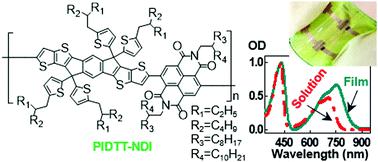当前位置:
X-MOL 学术
›
J. Mater. Chem. C
›
论文详情
Our official English website, www.x-mol.net, welcomes your
feedback! (Note: you will need to create a separate account there.)
n-Channel organic phototransistors with an n-type conjugated polymer based on indacenodithiophene and naphthalenediimide units
Journal of Materials Chemistry C ( IF 5.7 ) Pub Date : 2020-09-17 , DOI: 10.1039/d0tc02456b Saebom Lee 1, 2, 3, 4, 5 , Chulyeon Lee 1, 2, 3, 4, 5 , Hwajeong Kim 1, 2, 3, 4, 5 , Youngkyoo Kim 1, 2, 3, 4, 5
Journal of Materials Chemistry C ( IF 5.7 ) Pub Date : 2020-09-17 , DOI: 10.1039/d0tc02456b Saebom Lee 1, 2, 3, 4, 5 , Chulyeon Lee 1, 2, 3, 4, 5 , Hwajeong Kim 1, 2, 3, 4, 5 , Youngkyoo Kim 1, 2, 3, 4, 5
Affiliation

|
Here we report n-channel organic phototransistors (OPTRs) with a soluble n-type conjugated polymer, as a sensing channel layer, poly(5,5,11,11-tetrakis(5-(2-ethylhexyl)thiophene-2-yl)-dithieno[2,3-d:2′,3′-d′]-s-indaceno[1,2-b:5,6-b′]dithiophene)-co-2,7-bis(2-octyldodecyl)benzo[lmn][3,8]phenanthroline-1,3,6,8(2H,7H)-tetraone (PIDTT-NDI). The PIDTT-NDI polymer was synthesized by polymerization of the corresponding IDTT and NDI monomers via the Stille coupling reaction. The PIDTT-NDI films exhibited an optical absorption edge of ca. 900 nm and the lowest unoccupied molecular orbital (LUMO) energy of ca. −4.2 eV. The organic field-effect transistors (OFETs) with the PIDTT-NDI channel layers showed n-channel transistor behaviors and their best performances in the dark were measured at the PIDTT-NDI thickness of t = 70 nm. The photosensing test disclosed that the OPTRs with the PIDTT-NDI sensing channel layers could detect both blue (434 nm) and near infrared (754 nm) light irrespective of the PIDTT-NDI thickness, even though the best photoresponsivity (RC) was achieved at t = 70 nm. The flexible OPTRs with the 70 nm-thick PIDTT-NDI sensing channel layers, which were fabricated using poly(ethylene naphthalene) (PEN) film substrates, could detect both blue (420 nm) and deep red (700 nm) light. The present, flexible PIDTT-NDI-based OPTRs are expected to be applied for the skin therapy systems which need the blue (400–420 nm) and red (620–700 nm) light for the acne and anti-aging treatments, respectively.
中文翻译:

具有基于茚并二噻吩和萘二酰亚胺单元的n型共轭聚合物的n沟道有机光电晶体管
在这里我们报告与可溶性n型共轭聚合物的n通道有机光电晶体管(OPTRs)作为感测通道层,聚(5,5,11,11-四(5-(2-乙基己基)噻吩-2-基) -二噻吩并[2,3- d:2',3'- d '] -小号-indaceno [1,2 b:5,6- b ']二噻吩) -共-2,7-二(2-辛基十二烷基)苯并[ lmn ] [3,8]菲咯啉-1,3,6,8(2 H,7 H)-四酮(PIDTT-NDI)。所述PIDTT-NDI聚合物通过相应IDTT和NDI单体的聚合而合成通过Stille偶联反应。该PIDTT,NDI薄膜的光学吸收边缘约为。900 nm,最低的未占据分子轨道(LUMO)能量约为 −4.2 eV。具有PIDTT-NDI沟道层的有机场效应晶体管(OFET)显示了n沟道晶体管的行为,并且在PIDTT-NDI厚度为t = 70 nm的情况下测量了其在黑暗中的最佳性能。公开了与所述OPTRs所述光感测试PIDTT-NDI传感通道层可检测两个蓝色(434纳米)和近红外(754纳米)的光而不管PIDTT-NDI即使最好的光响应(厚度,- [R Ç)达到在t= 70 nm。具有70 nm厚PIDTT-NDI感测通道层的柔性OPTRs是使用聚(乙烯萘)(PEN)薄膜基板制造的,可以同时检测蓝色(420 nm)和深红色(700 nm)的光。目前,基于PIDTT-NDI的灵活OPTR有望被用于皮肤治疗系统,该系统分别需要蓝光(400-420 nm)和红光(620-700 nm)进行痤疮和抗衰老治疗。
更新日期:2020-10-19
中文翻译:

具有基于茚并二噻吩和萘二酰亚胺单元的n型共轭聚合物的n沟道有机光电晶体管
在这里我们报告与可溶性n型共轭聚合物的n通道有机光电晶体管(OPTRs)作为感测通道层,聚(5,5,11,11-四(5-(2-乙基己基)噻吩-2-基) -二噻吩并[2,3- d:2',3'- d '] -小号-indaceno [1,2 b:5,6- b ']二噻吩) -共-2,7-二(2-辛基十二烷基)苯并[ lmn ] [3,8]菲咯啉-1,3,6,8(2 H,7 H)-四酮(PIDTT-NDI)。所述PIDTT-NDI聚合物通过相应IDTT和NDI单体的聚合而合成通过Stille偶联反应。该PIDTT,NDI薄膜的光学吸收边缘约为。900 nm,最低的未占据分子轨道(LUMO)能量约为 −4.2 eV。具有PIDTT-NDI沟道层的有机场效应晶体管(OFET)显示了n沟道晶体管的行为,并且在PIDTT-NDI厚度为t = 70 nm的情况下测量了其在黑暗中的最佳性能。公开了与所述OPTRs所述光感测试PIDTT-NDI传感通道层可检测两个蓝色(434纳米)和近红外(754纳米)的光而不管PIDTT-NDI即使最好的光响应(厚度,- [R Ç)达到在t= 70 nm。具有70 nm厚PIDTT-NDI感测通道层的柔性OPTRs是使用聚(乙烯萘)(PEN)薄膜基板制造的,可以同时检测蓝色(420 nm)和深红色(700 nm)的光。目前,基于PIDTT-NDI的灵活OPTR有望被用于皮肤治疗系统,该系统分别需要蓝光(400-420 nm)和红光(620-700 nm)进行痤疮和抗衰老治疗。











































 京公网安备 11010802027423号
京公网安备 11010802027423号